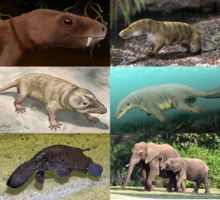| Eucynodonts Temporal range: Early Triassic-Holocene,
| |
|---|---|

| |
| Examples of eucynodonts. 1st row: Trirachodon berryi, Probainognathus jenseni; | |
| Scientific classification | |
| Domain: | Eukaryota |
| Kingdom: | Animalia |
| Phylum: | Chordata |
| Clade: | Synapsida |
| Clade: | Therapsida |
| Clade: | Cynodontia |
| Clade: | Epicynodontia |
| Clade: | Eucynodontia Kemp, 1982 |
| Subgroups | |
Eucynodontia ("true dog teeth") is a clade of cynodont therapsids including mammals and most non-mammalian cynodonts. The oldest eucynodonts are known from the Early Triassic and possibly Late Permian. Eucynodontia includes two major subgroups, Cynognathia and Probainognathia.[1]
The clade was named in 1982 by Thomas Kemp, who defined it as all cynodonts more derived than Thrinaxodon.[2][3]
In 2001, Hopson and Kitching redefined the clade Eucynodontia as the least inclusive group containing Mammalia and Exaeretodon.[4]
YouTube Encyclopedic
-
1/1Views:31 483
-
Is the Natural World Predictable?
Transcription
Phylogeny
Cladogram after Stefanello et al. (2023):[5]
| |||||||||||||||||||||||||||||||||||||||||||||||||||||||||||||||||||||||||||||||||||||||||||||||||||||||||||||||||||||||||||||||||||||||||||||||||||||||||||||||||||||||||||||||||||||
References
- ^ Rubidge, B.S.; Sidor, C.A. (2001). "Evolutionary patterns among Permo-Triassic therapsids" (PDF). Annual Review of Ecology, Evolution, and Systematics. 32: 449–480. doi:10.1146/annurev.ecolsys.32.081501.114113. Archived from the original (PDF) on 2012-03-21.
- ^ T.S. Kemp. 1982. Mammal-like Reptiles and the Origin of Mammals 363 pp
- ^ Martínez, R. N.; Fernandez, E.; Alcober, O. A. (2013). "A new non-mammaliaform eucynodont from the Carnian-Norian Ischigualasto Formation, Northwestern Argentina". Revista Brasileira de Paleontologia. 16: 61–76. doi:10.4072/rbp.2013.1.05.
- ^ James A. Hopson and James W. Kitching, 2001, "A Probainognathian Cynodont from South Africa and the Phylogeny of Nonmammalian Cynodonts" pp 5-35 in: PARISH A. JENKINS, JR., MICHAEL D. SHAPIRO, AND TOMASZ OWERKOWICZ, EDITORS, STUDIES IN ORGANISMIC AND EVOLUTIONARY BIOLOGY IN HONOR OF A. W. CROMPTON Bullettin of the Museum of Comparative Zoology. Harvard University 156(1)
- ^ Stefanello, M.; Martinelli, A. G.; Müller, R. T.; Dias-da-Silva, S.; Kerber, L. (2023). "A complete skull of a stem mammal from the Late Triassic of Brazil illuminates the early evolution of prozostrodontian cynodonts". Journal of Mammalian Evolution. doi:10.1007/s10914-022-09648-y.






